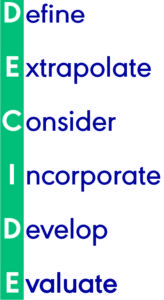I'm excited to have a guest post from Mariel Solomon, a previous school based SLP, who works for ASHA's National Center for Evidence Based Practice in Communication Disorders today!

You Have the Power to DECIDE
Making clinical decisions can be tricky, especially in the schools. There are so many things to balance like providing differentiated instruction that focuses on academically relevant goals to ensuring that you are delivering high-quality services that are also evidence-based. Unfortunately, there isn’t a recipe or playbook to do this, but ASHA has a tool that may make it easier. The newly-developed DECIDE framework provides a process to help you integrate the three components of evidence-based practice – external and internal evidence, clinical expertise, and client perspectives – into a clinical decision.
Let’s walk through the DECIDE framework using a situation you can relate to: you have a 2nd grade student who stutters and you want to provide evidence-based services. Here’s how to get started:

Define
Define your clinical question: What are effective interventions for children who stutter?
Having a focused clinical question can make it easier to search for and find relevant information, but there is A LOT of information out there. To save time, search resources that are already focused on communication and swallowing disorders like the ASHA Evidence Maps, the ASHA Practice Portal, or ASHAWire.
Extrapolate
Extrapolate clinically relevant information from the evidence like specific intervention protocols and how often the participants received the intervention.
Don’t forget to make sure that any external evidence you use is trustworthy. There are a few ways to figure out if the research you found is reliable; but if you’re short on time, resources like the ASHA Evidence Maps already have appraised systematic reviews, meta-analyses, and clinical practice guidelines, so that you can easily see the quality of the article.

Consider
Consider your clinical training, knowledge, and clinical experience along with any information you have gathered. You can also refer to the expertise of others by consulting clinical practice guidelines or a trusted colleague who may have more experience with students who stutter.
Incorporate
Incorporate the perspectives of your student, the student’s family, and others (e.g., teachers). IEP meetings are an ideal time to find out what is most important to students and their families and to develop a treatment plan that addresses their priorities, values, and expectations. For example, if your student wants to be fluent for a speaking part in the winter concert, you may want to develop a treatment plan that targets fluency in high-stress situations.
Develop
Develop a treatment plan by integrating all three components of EBP. Although you should consider all the components of EBP, there may be times you have to prioritize one component over another. For example, you know your student tends to be more responsive with more frequent but shorter sessions. So, you may have to use your clinical expertise to adapt the schedule defined in an evidence-based treatment program to keep your student engaged and progressing toward their winter concert goal.
Evaluate
Evaluate your clinical decision. Examine your student’s data to determine if they are making adequate progress. If not, adjust your treatment plan or go through the EBP process again to figure out where you need to re-focus your efforts. In our clinical example, if the student who stutters has plateaued in treatment and you notice that they have been expressing more negative feelings about their stuttering, then you may have to reprioritize your intervention to focus more on counseling and education.
Speech-language pathology services live on a dynamic continuum of diagnosis and treatment. We are problem-solvers and ASHA has some tools that can help. Visit the ASHA website to check out these EBP resources:
- Evidence-based practice and its process
- DECIDE Framework
- ASHA Evidence Maps
- ASHA Practice Portal
- ASHAWire
Mariel Solomon, MS, CCC-SLP, is a clinical research associate for ASHA's National Center for Evidence-Based Practice in Communication Disorders (N-CEP), where she focuses on pediatric speech-language pathology topics for resources such as the ASHA Evidence Maps. Prior to working at ASHA, she was a clinician in a variety of school settings ranging from early intervention to post-secondary education services.








![Speech-Language Pathologists (SLPs) play a crucial role in children's language development. One often overlooked but highly beneficial area to incorporate into speech therapy sessions is print knowledge. Understanding the importance of print knowledge can enhance therapy outcomes and foster literacy skills in children. I recently worked on a paper with some colleagues about the importance […]](https://i.pinimg.com/236x/ce/7f/bd/ce7fbd4a90a9683531d8b43d60ee2a68.jpg)
![Are you gearing up to supervise Speech-Language Pathology (SLP) graduate students this semester? Wondering how to initiate a positive and welcoming atmosphere? Here's a glimpse into a simple yet effective approach: Welcome Email: Setting the Tone A few days before the semester kicks off, I initiate a warm welcome by sending out a thoughtful email […]](https://i.pinimg.com/236x/c9/6b/cc/c96bccc987e6dacdaaf50eb3db1b9c47.jpg)

